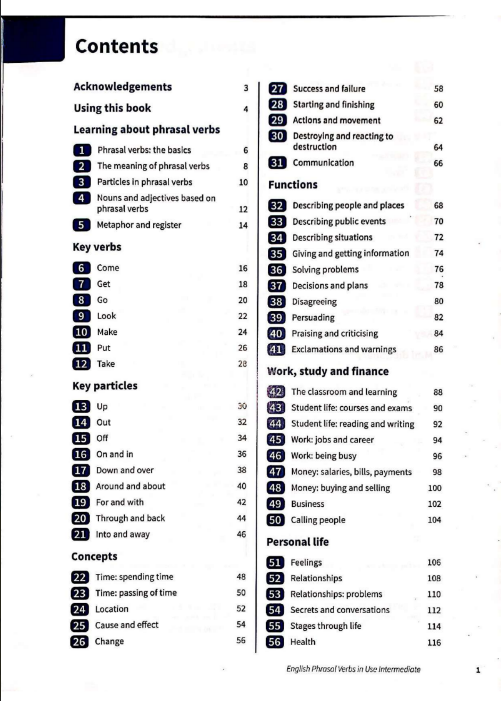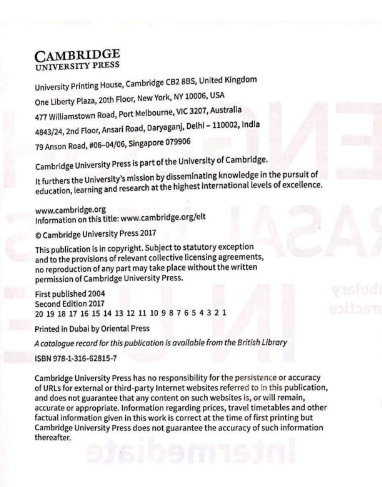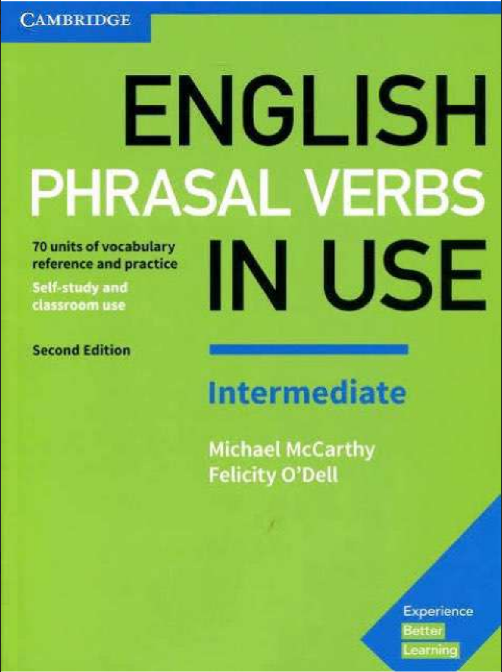


**Acknowledgements** Joy Godwin wrote two new units for the Second Edition: Unit 64, Mobile devices, and Unit 70, Academic writing. The publishers would like to thank Joy for her contribution to this edition. The authors and publishers acknowledge the following sources of copyright material and are grateful for the permissions granted. While every effort has been made, it has not always been possible to identify the sources of all the material used, or to trace all copyright holders. If any omissions are brought to our notice, we will be happy to include the appropriate acknowledgements on reprinting and in the next update to the digital edition, as applicable. Key: BL = Below Left, BR = Below Right, CR = Centre Right, CL = Centre Left, TL = Top Left, TR = Top Right. **Photographs** All the photographs are sourced from Getty Images. p. 9: John P. Kelly/The Image Bank; p. 13: beyhanayazar/iStock; p. 14 (photo 1): Tom Merton/OJO images; p. 14 (photo 2): Bruce Forster/The Images Bank; p. 14 (photo 3): Westend61; p. 26: Alex Wilson/DigitalVision; p. 26 (BR): John Orrell Perspectives; p. 26 (BR): Mark Cardy/Stringer; p. 35: Adsorb/Sutthiwanicha/Getty Im; p. 37 (TL): Sam Diepe/Glowimages/Getty Images; p. 37 (CL): romdelica/ iStock; p. 37 (BL) & p. 120: Hero Images; p. 37 (TR): Hill Street Studios/Blend Images; p. 37 (CR): Alistair Berg/DigitalVision; p. 37 (BR): Richard Drury/Stone; p. 38: Radius Images; p. 41: Rob Stothard/Stringer; p. 50: Yuri_Arcurs/DigitalVision; p. 51: Images Etc Ltd/Photographer’s Choice RF; p. 53 (photo 1): Allan Baxter/Photolibrary; p. 53 (photo 2): KenWiedemann/iStock; p. 53 (photo 3): Richard Webesky/Lonely Planet Images; p. 53 (photo 4): Zoonar RF/Zoonar/Getty Images Plus; p. 53 (photo 5): John Black/First Light/Trend tables; p. 55: FOAM/MomentOpen; p. 58: Daly and Newton/OJO images; p. 57 (TL): Image Source; p. 57 (TR): Claver Carroll/Photolibrary; p. 60: Zubin Shroff/ Stone; p. 63 (photo 1): Auscape/UIG/Universal Images Group; p. 63 (photo 2): Mark de Leeuw; p. 63 (photo 3): Jose Luis Peláez/The Image Bank; p. 63 (photo 4): lissart/iStock/Getty Images Plus; p. 63 (photo 5): David Malan/Photographer’s Choice; p. 63 (photo 6): Mike Kemp/Blend Images; p. 64: gpointstudio/iStock; p. 65 (photo 1): <Gbplipics/Westend61>; p. 65 (photo 2): Flying Colors Ltd/DigitalVision; p. 65 (photo 3): eyjafjallajokull/iStock/Getty Images Plus; p. 68 (CL): Ken Wiedemann/iStock; p. 68 (CR): Ray Kasprzak/The Image Bank; p. 68 (BL): Whites/ iStock; p. 68 (CR): Antenna; p. 70: inhousecreative/Getty Images Plus; p. 76: vadimuguzhva/ iStock; p. 79: Nico Kai/The Image Bank; p. 81: Roberto Machado Noa/LightRocket; p. 84: David Lees/DigitalVision; p. 85 (TL) & (CL): Juanmonino/E+; p. 85 (TR): John Rensten/Photographer’s Choice; p. 85 (CR): ioogga the Image Bank; p. 85 (BL): visualspace/iStock; p. 87: Commercial Eye/ The Image Bank; p. 94: Peter Dazely/Photographer’s Choice; p. 90: kwatt/Bookmedia Ltd/Getty Images Plus; p. 92 (TL): askeei/E+; p. 92 (BR): Briti/Veerle; p. 95: Claudia Bucher/Zoonar; p. 103: Jetta Productions/Blend Images; p. 104 (TR): EmirMemedevski; p. 104 (BR): Kevin C Moore/ Cultura; p. 104 (CR): Peopleimages/DigitalVision; p. 108: Amos Morgan/Photodisc; p. 119 (photo 1): Bernhard Lang/The Image Bank/iStock; p. 119 (photo 2): Michal Venera/Photolibrary; p. 119 (photo 3): Vasily Pindyurin; p. 126: Ken Redding/Corbis; p. 128 (TR): Carl Court/ p. 128 (BR): romdinka/ iStock; p. 134 (photo): E-Art/ Stock/Getty Images Plus; p. 132 (tablets): Matej Froloň/Photographer’s Choice; p. 132 (notebook): Angelika-Angelika/iStock/Getty Images Plus; p. 133: drb.images/E+; p. 136: 123ducu/iStock; p. 140: DEA/W. BUSS; p. 145: Paul Bradbury/Calaimage. **Ludmila** (KJA Artists), Katie Mac (NB Illustration), Gavin Reece (New Division) and Miguel Diaz Rivas (Advocate Art). **Cambridge Dictionaries** The Cambridge Dictionaries are the world’s most widely used dictionaries for learners of English. The dictionaries are available in print and online at dictionary.cambridge.org. Copyright © Cambridge University Press. reproduced with permission. — **Image 2: Using this book** **Using this book** **Why was this book written?** It was written to help you improve your knowledge of phrasal verbs in English. Phrasal verbs are verbs which have a main verb and a particle which, together, create one meaning (e.g. a plane takes off from the airport; an adult looks after a child). You will come across a great many phrasal verbs when you listen to and read English, and so it is important that you learn about their meanings and about how they are used. You can use this book either with a teacher or for self-study. There are more than 5,000 phrasal verbs and related noun and adjective forms in use in English. This book focuses just on those phrasal verbs which you need to know for everyday spoken and written communication in English, and it aims to provide the information and practice which will help you understand and use them correctly. **How were the phrasal verbs in the book selected?** The approximately 1,000 phrasal verbs and related noun and adjective forms that are presented in this book were mainly selected from those identified as significant by the CANCODE corpus of spoken English developed at the University of Nottingham in association with Cambridge University Press, and the Cambridge International Corpus of written and spoken English (now known as the Cambridge English Corpus). You can also find them in the Cambridge Dictionary online by going to the following website: http://dictionary.cambridge.org. **How is the book organised?** The book has 70 two-page units. The left-hand page explains the phrasal verbs that are presented in the unit. You will usually find an explanation of the meaning of each phrasal verb, an example of it in use and, where appropriate, any special note about its usage. The right-hand page checks that you have understood the information on the left-hand page by giving you a series of exercises that practise the material just presented. The exercises pay particular attention to checking understanding of the phrasal verbs and how they are used so that you will be able to use them accurately and appropriately. The units are organised into different sections: First we start with important information about phrasal verbs (Units 1–5): what they are, how their grammar works and so on. This is an important training section, and we recommend you do these units first. After the introductory units, there are units on the most common phrasal verbs which are used to form phrasal verbs (Units 6–12) and units on the most common particles found in phrasal verbs (Units 13–21). The rest of the book teaches you the phrasal verbs which are associated with particular concepts (e.g. time), functions (e.g. giving and getting information) and topics (e.g. business, feelings, student life). The book also has a key to all the exercises so that you can check your answers. At the back of this book, you will find a useful Mini dictionary. This provides clear definitions of all the phrasal verbs and related noun and adjective forms that appear in this book. The Mini dictionary also indicates the unit number where you can find a particular phrasal verb. **How should I use this book?** It is strongly recommended that you work through Units 1–5 first so that you become familiar with the way phrasal verbs operate and with the terminology that is used in the rest of the book. After that, you may work on the units in any order that suits you. **What else do I need in order to work with this book?** You need a notebook or file in which you can write down the phrasal verbs that you study in this book as well as any others that you come across elsewhere. You also need to have access to a good dictionary. We strongly recommend the Cambridge Phrasal Verbs Dictionary as this gives exactly the kind of information that you need to have about phrasal verbs. Your teacher, however, may also be able to recommend other dictionaries that you will find useful. We hope that this book will help you understand and use new or difficult phrasal verbs that crop up (see Unit 44 Student life: reading and writing) in your reading and listening in English and that, by the time you finish the units, you’ll be saying: ‘English phrasal verbs? Show me a new one and I’ll figure out what it means in seconds!’ (see Unit 69 American and Australian phrasal verbs). — **Image 3: What are phrasal verbs? & What do I need to know about phrasal verbs?** **What are phrasal verbs?** Phrasal verbs are verbs that consist of a verb and a particle. | verb | particle | example | meaning | | look | up | You can look up any new words in your dictionary. | You can find the meaning of any new words in your dictionary. | | go | through | I will go through your application form with you. | I will carefully read your application form and discuss it with you to make sure that it is correct. | | make | out | I just can’t make Jake out at all. | I can’t understand Jake’s behaviour. | Particles are small words which you already know as prepositions or adverbs. Here are some of the most common phrasal verb particles: about (a)round at away back down for in into on out over through to up **What do I need to know about phrasal verbs?** First you need to know the meaning of the whole phrasal verb as a unit. The Mini dictionary in this book will help you. For example, look up means to use your eyes and up means the opposite of down, but the phrasal verb look up can have several different meanings. Look the word up in the dictionary. [look up = search for information in a book/computer] I’ll look you up next time I’m in London. [look up = visit someone you have not seen for a long time] Things are looking up. [look up = improve] Next you need to know the grammar patterns of phrasal verbs, e.g. whether the verb takes an object. The table shows that the grammar patterns are shown in this book and in many dictionaries. | grammar pattern | comment | example | | eat out | the verb is used without an object | We were too tired to cook at home so we decided to eat out. [eat in a restaurant] Not: We decided to eat out a meal. | | bring back sth back | the verb must have a non-human object | This photograph brings back happy memories. [makes me remember or think about something from the past] Not: This photograph brings back my sister. | | ask sb out or ask sb out | the verb-human object has to have a human object | I’d love to ask Poppy out. [invite Poppy to go to a place like a cinema or a restaurant] | | look after sb/sth | the object can be either human or non-human | I’ll look after the baby while you’re cooking. Will you look after my plants while I’m away? | | ring sb back | the object must come before the particle | I’ll ring back later. [phone you again] Not: I’ll ring back-you. | | look after sb/sth | the object must come after the particle | Can you look the dog after while I’m away? Not: Can you look the dog after while I’m away? | | drop off sth / or drop sth/sth off | the object can be before or after the particle | I dropped off the present at her house. [delivered/left] I dropped the present off at her house. |


